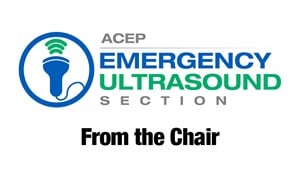
Cases That Count: Back Pain in the ED – Hypotensive and Confused
Questions
- What ultrasound protocol could be used to identify the etiology of undifferentiated hypotension in this patient?
- What are the findings demonstrated in this clip?
- How would your impression change in the setting of pyuria?
Case Presentation
A 72-year-old female with dementia, hypothyroidism, hypertension, and bilateral above-knee amputations due to peripheral vascular disease presented to the emergency department (ED) from a skilled nursing facility with hypotension. Transfer paperwork disclosed two weeks of intermittent fevers for which the patient had been treated empirically with cefuroxime for presumed pneumonia.
On arrival, her blood pressure was 101/57, pulse was 89, temperature was 97.7 F, and oxygen saturation was 92%. She was alert but oriented only to person. No further history could be obtained from the patient. Her head and neck exam was unremarkable. Her lungs were clear to auscultation in all fields and her abdomen was soft and non-tender. Her extremities showed bilateral above-knee amputations without edema, and good range of motion at the hip joint. Her skin was warm and dry without rash or lesions.
Laboratory testing was sent, and a POCUS was performed in an attempt to determine the most likely etiology for her hypotension. Starting with an assessment of her inferior vena cava, which was flat, the operator moved to the right mid-axillary line to assess for a right lower lobe pneumonia and free fluid in Morison’s pouch. Both views were negative for these pathologies. However, while viewing Morison’s pouch the right kidney exhibited moderate hydronephrosis with complex fluid and hydroureter (Video 1). The left kidney was imaged next and demonstrated no evidence of hydronephrosis.
A chest x-ray was obtained and revealed a small infiltrate suspicious for pneumonia. Her white blood cell count was 33.6 with a left shift. A urinalysis showed pyuria with some bacteria and red cells. Given her leukocytosis, pyuria, and hydronephrosis on POCUS, computed tomography (CT) imaging of the abdomen and pelvis was ordered to assess for an infected ureteral stone. The CT revealed a stone measuring 1.3 cm in the right proximal ureter (Video 2). The patient was immediately taken to the operating room by urology for placement of a ureteral stent. She was discharged from the hospital two days later.
Role of POCUS in the Evaluation of Obstructive Uropathy
POCUS should be the initial imaging test performed on patients presenting to the ED with renal colic.1 It detects nephrolithiasis with moderate sensitivity and specificity, with increased accuracy in the setting of moderate or severe hydronephrosis and in the hands of experienced physicians.2,3 It can also detect ureteral stones at the ureteropelvic junction or the ureterovesicular junction.4 Most (80%) ureteral stones pass spontaneously. However, with increasing size spontaneous passage becomes less likely, occurring in only 9% of stones larger than 6.5mm.5
The classic presentation of renal colic is acute-onset, severe unilateral flank pain with hematuria. In this context, mild or moderate hydronephrosis on POCUS supports the diagnosis of ureterolithiasis.6 However, flank pain is not the only indication for POCUS of the kidneys. In this case, hydronephrosis was discovered in the context of hypotension and altered mental status. Our patient was ultimately diagnosed with urosepsis secondary to a urinary tract infection (UTI) caused by ureteral obstruction. Later in her hospital course, she was able to disclose a recent history of flank pain along with her intermittent fever. Because a stone was not observed sonographically, CT was required to identify the source of obstruction.
Two-thirds of cases of obstructive pyelonephritis are secondary to ureteral stones. This is an acute urologic emergency associated with a significant risk of morbidity and mortality. In a study of more than 1700 patients who had ureteral stones and sepsis, mortality without surgical intervention was 19% versus 9% among patients who underwent surgery.7 In about 10% of patients with septic shock due to a UTI, obstructive uropathy is the precipitating factor. 8 It is prudent, therefore, to have a low threshold for imaging patients with sepsis from a suspected urinary source to differentiate obstructive from non-obstructive pathology.
This patient could easily have been admitted to the medicine service for pneumonia and UTI. However, incorporating POCUS raised concern for an infected ureteral stone and expedited emergent surgical management.
Answers
1. What ultrasound protocol could be used to identify the etiology of undifferentiated hypotension in this patient?
When assessing the hypotensive patient with an unclear etiology, it is important to have a methodical approach. The Rapid Ultrasound in Shock (RUSH) protocol is a systematic approach to evaluating the hypotensive patient evaluates the body with respect to the “pump”, “tank”, and “pipes”. A more detailed discussion of this is available here.
2. What are the findings demonstrated in this clip?
The clip shows hydronephrosis containing complex fluid and hydroureter, which is concerning for ureteral obstruction. The complex appearance of the fluid is likely due to the associated pyuria.
3. How would your impression change in the setting of pyuria?
Unilateral hydronephrosis in the setting of pyuria is concerning for an infected ureteral stone and should prompt consideration of CT imaging to confirm the presence and location of the stone for surgical management. Additionally, pyuria in the setting of hypotension should signal providers to perform a renal POCUS to look for hydronephrosis, which would suggest an obstructive etiology resulting in a change in management, as in the above case.
References
- Smith-Bindman R, Aubin C, Bailitz J, et al. Ultrasonography versus computed tomography for suspected nephrolithiasis. N Engl J Med. 2014;371(12):1100-10.
- Wong C, Teitge B, Ross M, et al. The accuracy and prognostic value of point-of-care ultrasound for nephrolithiasis in the emergency department: A systematic review and meta-analysis. Acad Emerg Med. 2018;25(6):684-98.
- Herbst MK, Rosenberg G, Daniels B, et al. Effect of provider experience on clinician-performed ultrasonography for hydronephrosis in patients with suspected renal colic. Ann Emerg Med. 2014;64(3):269-76.
- Bomann JS, Seman M, Sutijono D, et al. The bladder bulge: unifying sonographic bladder abnormalities in ureterolithiasis. West J Emerg Med. 2012;13(6):517-23.
- Jendeberg J, Geijer H, Alshamari M, et al. Size matters: The width and location of a ureteral stone accurately predict the chance of spontaneous passage. Eur Radiol. 2017;27(11):4775-85.
- Hassani, B. Kidneys. In: N. Sori, R. Arntfield and P. Kory, eds. Point-of-Care Ultrasound. Philadelphia: Saunders, 2014, 153-161.
- Vahlensieck W, Friess D, Fabry W, et al. Long-term results after acute therapy of obstructive pyelonephritis. Urol Int. 2015;94(4):436-41.
- Reyner K, Heffner AC, Karvetski CH. Urinary obstruction is an important complicating factor in patients with septic shock due to urinary infection. Am J Emerg Med. 2016;34(4):694-6.
Samuel Southgate, MS3
Meghan Kelly Herbst, MD, FACEP
Department of Emergency Medicine, Hartford Hospital



